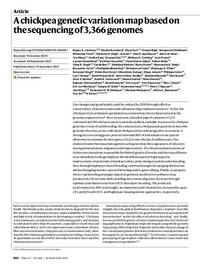Authors:
Rajeev Varshney
Manish Roorkiwal, Shuai Sun, Shuai Sun, Prasad Bajaj, Annapurna Chitikineni, Mahendar Thudi, Mahendar Thudi, Narendra P. Singh, Xiao Du, Xiao Du, Hari D. Upadhyaya, Hari D. Upadhyaya, Aamir Khan, Yue Wang, Yue Wang, Garg Vanika, Guangyi Fan, Guangyi Fan, Wallace Cowling, Jose Crossa, Laurent Gentzbittel, Kai Peter Voss-Fels, Vinod Kumar, Sinha Pallavi, Vikas Singh, Vikas Singh, Cecile Ben, Cecile Ben, Abhishek Rathore, Punna Ramu, Muneendra K. Singh, Bunyamin Taran, Bharadwaj Chellapilla, Yasin Mohammad, Motisagar S. Pithia, Servejeet Singh, Khela Ram Soren, Hima bindu Kudapa, Diego Jarquin, Philippe Cubry, Lee Hickey, Girish Prasad Dixit, Anne-Céline Thuillet, Aladdin Hamwieh, Shiv Kumar Agrawal, Amit A Deokar, Sushil k. Chaturvedi, Aleena Francis, Reka Howard, Debasis Chattopadhyay, David Edwards, Eric Lyons, Vigouroux Yves, Ben J Hayes, Eric J. B. von Wettberg, Swapan Kumar Datta, Huanming Yang, Huanming Yang, Henry T. Nguyen, Jian Wang, Kadambot H M Siddique, Trilochan Mohapatra, Jeffrey L Bennetzen, Xun Xu, Xin Liu
Zero hunger and good health could be realized by 2030 through effective conservation, characterization and utilization of germplasm resources1. So far, few chickpea (Cicer arietinum) germplasm accessions have been characterized at the genome sequence level2. Here we present a detailed map of variation in 3,171 cultivated and 195 wild accessions to provide publicly available resources for chickpea genomics research and breeding. We constructed a chickpea pan-genome to describe genomic diversity across cultivated chickpea and its wild progenitor accessions. A divergence tree using genes present in around 80% of individuals in one species allowed us to estimate the divergence of Cicer over the last 21 million years. Our analysis found chromosomal segments and genes that show signatures of selection during domestication, migration and improvement. The chromosomal locations of deleterious mutations responsible for limited genetic diversity and decreased fitness were identified in elite germplasm. We identified superior haplotypes for improvement-related traits in landraces that can be introgressed into elite breeding lines through haplotype-based breeding, and found targets for purging deleterious alleles through genomics-assisted breeding and/or gene editing. Finally, we propose three crop breeding strategies based on genomic prediction to enhance crop productivity for 16 traits while avoiding the erosion of genetic diversity through optimal contribution selection (OCS)-based pre-breeding. The predicted performance for 100-seed weight, an important yield-related trait, increased by up to 23% and 12% with OCS- and haplotype-based genomic approaches, respectively.
Citation:
Rajeev Varshney, Manish Roorkiwal, Shuai Sun, Prasad Bajaj, Annapurna Chitikineni, Mahendar Thudi, Narendra P. Singh, Xiao Du, Hari D. Upadhyaya, Aamir Khan, Yue Wang, Garg Vanika, Guangyi Fan, Wallace Cowling, Jose Crossa, Laurent Gentzbittel, Kai Peter Voss-Fels, Vinod Kumar, Sinha Pallavi, Vikas Singh, Cecile Ben, Abhishek Rathore, Punna Ramu, Muneendra K. Singh, Bunyamin Taran, Bharadwaj Chellapilla, Yasin Mohammad, Motisagar S. Pithia, Servejeet Singh, Khela Soren, Hima bindu Kudapa, Diego Jarquin, Philippe Cubry, Lee Hickey, Girish Prasad Dixit, Anne-Céline Thuillet, Aladdin Hamwieh, Shiv Kumar Agrawal, Amit A Deokar, Sushil k. Chaturvedi, Aleena Francis, Reka Howard, Debasis Chattopadhyay, David Edwards, Eric Lyons, Vigouroux Yves, Ben J Hayes, Eric J. B. von Wettberg, Swapan Datta, Huanming Yang, Henry T. Nguyen, Jian Wang, Kadambot H M Siddique, Trilochan Mohapatra, Jeffrey Bennetzen, Xun Xu, Xin Liu. (10/11/2021). A chickpea genetic variation map based on the sequencing of 3, 366 genomes. Nature, 599, pp. 622-627.
Keywords:
natural variation in plants
structural variations
agricultural genetics

